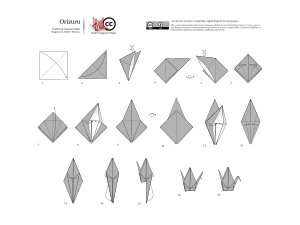吉泽-兰德列特系统
此条目需要扩充。 (2015年3月20日) |
吉泽-兰德列特系统(英语:Yoshizawa–Randlett system)是一种折纸图解系统,专门用来描述折纸模型的折叠过程,是一种折纸步骤图的表达系统。在许多折纸书籍中,首先都会介绍一些基本的折纸技巧,这些技巧是构建折纸模型的基础。不同书籍可能会使用不同的折纸步骤图的表达系统,通常会在书籍的首章或附录介绍,如无特别说明则通常默认为吉泽-兰德列特系统。此外,有几种常用的标准基本形状,通常作为折纸的第一步。根据制作过程中所需技巧的复杂程度,折纸模型通常被分为初、中或高级难度。

历史
编辑折纸图解这个概念首次出现于1797年的《秘传千羽鹤折形》,这本书是历史上第一本专门谈论折纸的书籍。初期的折纸图解非常模糊,通常只展示折叠完成后的成品,使得折纸者对整个创作过程一头雾水。
随后的折纸书籍试图透过各种方式,如繁复的符号系统或是每一步骤的照片和素描,来精准地展示折纸的过程。然而,这些方法都无法完整涵盖所有折纸模型,因此都未能广泛流行。
到了1950至60年代,日本折纸大师吉泽章提出了一套革命性的折纸图解系统。他在1954年发表的《新折纸艺术》(新らしいおりがみ芸術)中首次介绍了这套系统,其中运用了点线和虚线来分别代表山折和谷折,并融入了如“吹气”和“圆形”等新符号。这套方法引起了塞缪尔·兰德列特和罗伯特·哈宾的注意,他们又增加了如“旋转”和“放大”等符号,并将其定为标准。吉泽-兰德列特系统于1961年首次在兰德列特的《折纸艺术》(Art of Origami)中被详细介绍[1],并迅速成为全球折纸界的通用标准,至今仍被广泛使用。
折纸符号
编辑吉泽-兰德列特系统的折纸符号广泛出现于市售大部分折纸书籍中的折纸步骤图。在吉泽-兰德列特系统中,折纸符号有两种主要:线条和箭头[2]。箭头通常代表折纸时如何将纸弯曲或移动;而线条显示各种类型的边缘:
- 粗线代表纸张的边缘
- 虚线表示谷折。 纸张在自身前方折叠。
- 虚线和点线显示山折(每个破折号可能有一个或两个点,取决于作者)。 将纸张向后折叠,这通常是透过将纸张翻过来,折叠谷折,然后再次将纸张翻过来来完成的。
- 一条细线代表先前折叠使纸张产生折痕的位置。
- 以虚线表示隐藏在先前折叠后隐没于纸张后面的部分,或有会用虚线来代表尚未完成的折叠。
本文展示了相当的常见吉泽-兰德列特系统之折纸符号。段折 通常使用两个成一定角度的折痕来表达。中分折通常用于制作脚或鸟头。[4]
参考文献
编辑- ^ Nick Robinson. The Origami Bible. Chrysalis Books. 2004: 18. ISBN 978-1-84340-105-6.
- ^ Peter Engel. Origami from Anglefish to Zen. Dover. 1989: 8. ISBN 978-0486-28138-4.
- ^ 3.0 3.1 3.2 3.3 日本折纸学会発行 折纸探侦団
- ^ 摺紙步驟教學 - 小鳥. supercoloring.com. [2024-04-22]. (原始内容存档于2024-04-22).
- David Lister. The Origin of Origami Symbols. British Origami Society. [2014-08-09]. (原始内容存档于2020-11-13).
- Robert J. Lang. The Complete Book of Origami: step-by-step instructions in over 1000 diagrams. Dover Publications, Mineola, NY. Copyright 1988 by Robert J. Lang. ISBN 0-486-25837-8 (pbk.)
- Pages 1–30 are an excellent introduction to most of these skills. Each of these 13 models is designed to let you practice one skill several times. Unfortunately, the remaining 24 models leave out lots of pre-creases.
- Peter Engel. Origami from Angelfish to Zen. Dover Publications, Mineola, NY. Copyright 1989 by Peter Engel. ISBN 0-486-28138-8 (pbk.)
- Pages 1–88 explain how the crease patterns of the classic bases are related to each other, how they are examples of fractal design, and how it is possible to generate arbitrarily complex origami designs.
- Robert J. Lang. Origami Design Secrets: mathematical methods for an ancient art. A K Peters, Natick, MA. Copyright 2003 by A K Peters. ISBN 1-56881-194-2 (pbk)
- This book shows how crease patterns and folding techniques are related to the large-scale structure of a model. It also shows how closed-unsinking was derived, using Lang's TreeMaker software for prototyping arbitrarily complex origami designs.
- Tomoko Fuse. Unit Origami: multidimensional transformations. Japan Publications, inc. Tokyo. Copyright 1990 by Tomoko Fuse. ISBN 0-87040-852-6
- This is an excellent book about modular origami, and serves as a great introduction to geometric models and designs.
外部链接
编辑- OrigamiTube.com YouTube styled website with user submitted content (videos) on origami.
- www.folds.net/tutorial Folds.net Guide to paperfolding – Instructions on the Web (页面存档备份,存于互联网档案馆) is laid out in a similar order to this tech tree. It has pictures of simple models at the start, and pictures of complicated models at the end.
- An article on "Origami Diagramming Conventions (页面存档备份,存于互联网档案馆) by Robert J. Lang.
- HappyFolding.com (页面存档备份,存于互联网档案馆) Site featuring instructional origami videos, an origami dictionary, etc.